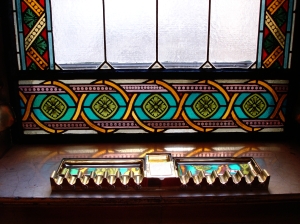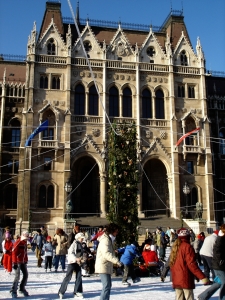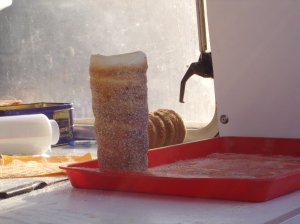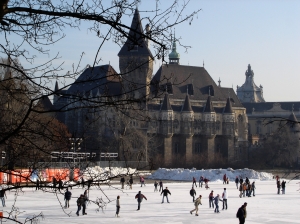
Growing up at my piano, in a small farmhouse on the edge of the Pacific, the great composers and the great European cities where they were born and performed were very real to me. But in the 1970s, so many thousands of miles away, it was impossible even to imagine visiting Budapest, so firmly hidden behind the Iron Curtain. But several years ago, we had the opportunity to visit. And appropriately, for me at least, from the start of our trip music set the scene– the man with the trumpet case in the queue at the airport, and the young student on the plane with his flute. I was going to the home of Liszt and Bartok, our hotel was the K&K Hotel Opera, just around the corner from the Opera House. The Franz Liszt Music Academy was just down the street. I was in heaven, as I am now, writing this to the strains of Liszt’s Hungarian Rhapsody #2 played by Rachmaninoff.
A tour of the Opera House was therefore compulsory, and a highlight. Ornate and magnificent, I felt transported back to the 18th and 19th centuries, when before the performances and at the intervals, men would throng around the smokers corridor with their cigars, and young lovers would meet in the alcoves, hidden by the smoke of 50 men and their cigars. How times have changed – now smoking is banned, and young lovers can meet openly! Our tour guide did an excellent job of promoting the opera, so that night we attended a performance. The price was about $8 for two seats up in the gods. The opera was Tchaikovsky – La Picque Dame – and was of course unintelligible – sung in Russian, and the subtitles were in Magyar. An English subtitle would have been handy. But we were at the opera, in Budapest, and it was wonderful.
Budapest reminded me very much of Vietnam and Cambodia. Streets and streets of wonderful old buildings, badly in need of a paintjob or renovation, still proudly recalled the faded grandeur of more prosperous times past, when Budapest was the centre of the Austro-Hungarian Empire in the 19th Century.

Magnificent cathedrals, huge parliament buildings, great boulevards, and wonderful old buildings. But in the midst of it all is the overlay of a communist past – the imposing, rigid, Soviet style architecture fortunately is not too common. But buying an international train ticket at the station just reminds you that you are in a country which has not enjoyed the same levels of development as those of us in the west, and has a way to go to reach “normal” efficiencies. The moral of the story is to allow plenty of time, and know exactly when and how you want to travel!
Budapest is a tale of two cities. Buda is the old royal capital on the hills on one side of the Danube river, and Pest is the commercial town down on the other side. Their character is very different, but they work well together. The sight of Buda from Pest is a treat at any time – at night, with the castle and cathedrals lit up, or on our first morning in the city, as we rounded a corner and suddenly saw the river and the hills, the castle and the cathedrals in the sunlight. Even the Danube is blue in Budapest.

We were there the week before Christmas, and enjoyed visiting Budapest’s Christmas market. It was small, in the Vörösmarty square in front of Gerbaud’s famous coffee shop, and filled with stalls of locally crafted Christmas gifts, and lots of food – mulled wine (Forat Bor in the Hungarian Magyar language) and stall after stall selling barbecued sausages, lots of pastries and cakes, and a local specialty, a honey bread. Because Budapest is on the same time zone as France and the Netherlands, the sun sets early. This photo of the market was taken about 4 in the afternoon.

We ate really well in Budapest, both traditionally – Goulasch had to be on the menu, along with the best hot chocolate in the world at Gerbaud’s coffee shop which is about 150 years old, and of course pastries and chocolate cakes and the honey bread they sell from stalls – and at more modern restaurants, which could have been transplanted from London, Sydney or Wellington. The best meal of that entire European trip was a divine salmon cream soup I had in Budapest our second night there.

Hungary’s parliament is the third largest in the world, and so is very grand, with great marble staircases, domes, paintings and statues. Once again, we were intrigued by stories of cigar smokers. Outside the debating chamber are rows of numbered cigar holders – even when it was designed, smoking in the chamber was banned, so so you could put your cigar down, remember which number it was in, and come out after the speaker to finish your cigar. If the representative was a good speaker, the cigars would all have burned down to a nub.
However the thing that stole my heart at the Parliament was what they do in the grounds the week before Christmas. Schools were out, and temperatures were low, so a small, temporary ice-skating rink was set up, right in front of the entrance.

The rink was full of children, flanked by their grandparents on babysitting duty while all the parents were still at work. Kürtös kalács, a popular Transylvanian pastry, was made fresh in a stall. Yum.

We later visited one of the famous spas. Due to time constraints, and to my regret, we didn’t indulge in one of the must-dos in Budapest – a visit to a bathhouse. In the midst of winter, the idea of soaking in hot pools was appealing – not least to us but also these ducks. 
But the skaters nearby were equally having fun.

Of course, Budapest has had a painful history. The sight of Heroes Square was already embedded in my memory, the sight of a celebrating nation in 1989, overlain with images of Russian tanks quelling their declaration of independence and withdrawal from the Warsaw Pact in 1956. The Jews of Budapest are remembered in the courtyard of the Synagogue, with a beautiful memorial – a metal weeping willow, its leaves engraved with their names.

I fell in love with Budapest.
I think I always knew I would.
Lovely! Budapest was not on my “cities to visit someday” list until this post.
I’m a little intimidated by going to countries where I don’t speak the language (which would be any country other than countries where English is the language). How do I get over that?
LikeLike
I can’t believe how much I’ve learned from this post. Bravo!
You must keep detailed journals…
LikeLike
i loved that i had the soundtrack set to start with. and i learned a lot too. i want to travel with you.
LikeLike
It’s funny, I never think of travelling in Eastern Europe. I think I always associate it with my one visit back when I was 11 or 12 to East Berlin. My main memories of that trip are guard dogs, guns, and greyness. I need to think about other places, like Budapest. And Prague.
LikeLike
IB: I do sometimes. Or I have letters I wrote after the trip still on my hard drive. But I remember most of it.
Lisa: Thanks. I think we’d all have a ball.
Helen: Watch out for P for Prague and B (maybe third time around) for Berlin – all visited on same trip.
LikeLike
I finally had time this morning to catch up on your travel blog. It’s fantastic. Travel writing in the newspaper is pathetic compared to your posts. Hurrah!
LikeLike
Why thank you sir!
LikeLike
CW: I’ve answered your question on A Separate Life
LikeLike
I love this post, and I love Budapest, it’s one of the best cities ever. I still haven’t made it to the Opera House but want to go next time. We always, always go to the Szechenyi Baths though.
LikeLike